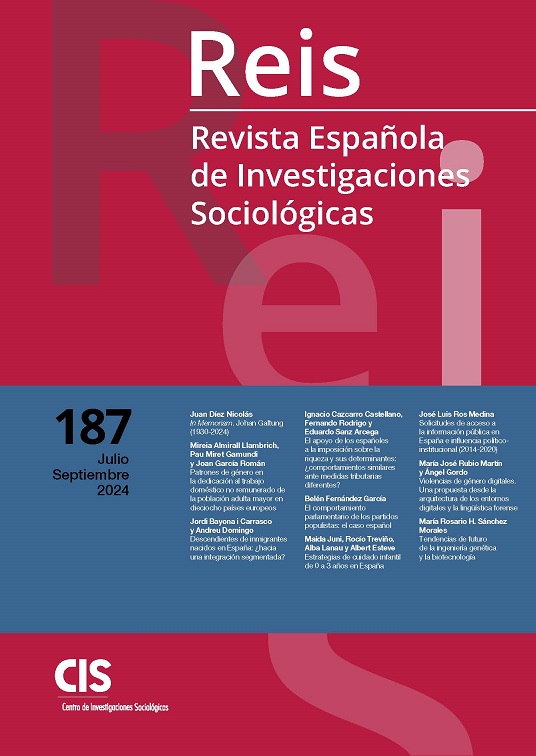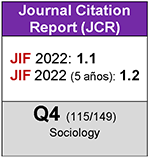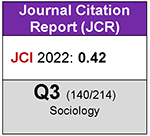Descendants of Immigrants Born in Spain: A Segmented Assimilation?
DOI:
https://doi.org/10.5477/cis/reis.187.25-44Keywords:
Descendants • ECEPOV • Spain • Educational Attainment • Segmented Assimilation • Unemployment • Second Generations, Descendants, ECEPOV, Spain, Educational Attainment, Segmented Assimilation, Unemployment, Second GenerationsAbstract
In 2021, approximately 2.65 million people born in Spain had at least one foreign-born parent, representing 6.5 % of the population,
although this percentage exceeds 30 % among children under the age of three, suggesting the future importance of these descendants of immigrants. The education levels attained and incorporation into the labour market among the first descendants arriving at young ages will be good indicators of the integration process. Our results show that the children of immigrants have lower levels of education and greater likelihood of being unemployed. These differences with the autochthonous population increase when both parents are of foreign origin, as well as for certain specific origins, which suggest the existence of segmented assimilation.
Downloads
References
Aparicio, Rosa y Portes, Alejandro (2014). Crecer en España. La integración de los hijos de inmigrantes. Barcelona: La Caixa.
Aparicio, Rosa; Biderbost, Pablo y Tornos, Andrés (2018). La integración de los jóvenes hijos de inmigrantes en el mercado laboral español. Madrid: Ministerio de Trabajo, Migraciones y Seguridad Social.
Arcarons, Albert F. y Muñoz, Jacobo (2018). «Paro y temporalidad de los inmigrantes que llegaron a España durante la infància». Anuario CIDOB de la Inmigración 2018: 184-209. DOI: https://doi.org/10.24241/AnuarioCIDOBInmi.2018.184
Bayona-i-Carrasco, Jordi y Domingo, Andreu (2018). «El fracaso escolar de los descendientes de la inmigración en Cataluña: más que una asignatura pendiente». Perspectives Demogràfiques, 18. DOI: https://doi.org/10.46710/ced.pd.esp.11
Bayona-i-Carrasco, Jordi; Domingo, Andreu y Menacho, Teresa (2020). «Trayectorias migratorias y fracaso escolar de los alumnos inmigrados y descendientes de migrantes en Cataluña». RIS, Revista Internacional de Sociología, vol. 78(1): e150. doi: 10.3989/ris.2020.78.1.18.107 DOI: https://doi.org/10.3989/ris.2020.78.1.18.107
Bayona-i-Carrasco, Jordi y Domingo, Andreu (2021). «La continuidad en el aula: el caso del alumnado de origen inmigrante en la transición hacia la educación posobligatoria en Cataluña». Aposta. Revista de Ciencias Sociales, 89: 123-141.
Behtoui, Alireza (2004). «Unequal Opportunities for Young People with Immigrant Backgrounds in the Swedish Labour Market». Labour, (18): 633-660. doi: 10.1111/j.1121-7081.2004.00281.x DOI: https://doi.org/10.1111/j.1121-7081.2004.00281.x
Breen, Richard y Jonsson, Jan O. (2005). «Inequality of Opportunity in Comparative Perspective: Recent Research on Educational Attainment and Social Mobility». Annual Review of Sociology, (31): 223-243. DOI: https://doi.org/10.1146/annurev.soc.31.041304.122232
Cachón, Lorenzo (2022). «Los inmigrantes jóvenes en el mercado de trabajo en España: la asimilación segmentada en acción». Mediterráneo Económico, 36: 19-36.
Cachón, Lorenzo y Aysa-Lastra, María (2021). Asimilación segmentada y trayectorias de clase: las segundas generaciones de inmigrantes en el mercado de trabajo en España. En: R. Aparicio y A. Portes (eds.). Los nuevos españoles. La incorporación de los hijos de inmigrantes (pp. 23-58). Barcelona: Bellaterra Edicions.
Cebolla-Boado, Héctor (2022). «¿Qué más hay detrás de la desventaja educativa de los inmigrantes? Tres ideas poco conocidas sobre su experiencia escolar». Mediterráneo Económico, 36: 189-205.
Checa, Juan C. y Arjona, Ángeles (2009). «La integración de los inmigrantes de “segunda generación” en Almería. Un caso de pluralismo fragmentado». Revista Internacional de Sociología, 67(3): 701-727. doi: 10.3989/ris.2008.04.17 DOI: https://doi.org/10.3989/ris.2008.04.17
Checa, Juan C. y Montserrat, Montserrat (2015). «La integración social de los hijos de inmigrantes africanos, europeos del Este y latinoamericanos: un estudio de caso en España». Universitas Psychologica, 14(2): 475-486. doi: 10.11144/Javeriana.upsy14-2.lish DOI: https://doi.org/10.11144/Javeriana.upsy14-2.lish
Cortina, Clara; Esteve, Albert y Domingo, Andreu (2006). «Crecimiento y singularidades demográficas de los matrimonios de extranjeros en España». Migraciones, 20: 75-105.
Crul, Maurice y Vermeulen, Hans (2003). «The Second Generation in Europe». International Migration Review, 37(4): 965-986. doi: 10.1111/j.1747-7379.2003.tb00166.x DOI: https://doi.org/10.1111/j.1747-7379.2003.tb00166.x
Crul, Maurice; Schnell, Philipp; Herzog-Punzenberger, Barbara; Wilmes, Maren; Slootman, Marieke y Aparicio, Rosa (2012). School Careers of Second-Generation Youth in Europe: Which Education Systems Provide the Best Chances for Success?. En: M. Crul, J. Schneider y F. Lelie (eds.). The European second generation compared: Does the integration context matter? (pp. 101-164). Amsterdam: Amsterdam University Press. DOI: https://doi.org/10.1017/9789048516926.005
Domingo, Andreu; Sabater, Albert y Ortega, Enrique (2014). «¿Migración neohispánica? El impacto de la crisis económica en la emigración espanyola». EMPIRIA. Revista de Metodología de las Ciencias Sociales, 29: 39-66. DOI: https://doi.org/10.5944/empiria.29.2014.12940
Eurostat (2011). Migrants in Europe. A Statistical Portrait of the First and Second Generation. Eurostat Statistical books.
Gil-Hernández, Carlos J. y Gracia, Pablo (2018). «Adolescents’ Educational Aspirations and Ethnic Background: The Case of Students of African and Latin American Migrant Origins in Spain». Demographic Research, 38(23): 577-618. DOI: https://doi.org/10.4054/DemRes.2018.38.23
González-Ferrer, Amparo y Cebolla-Boado, Héctor (2018). Los hijos de la inmigración en España: valores, aspiraciones y resultados. En: A. Blanco; A. Chueca; J. A. López y S. Mora (coords.). Informe España 2018 (pp. 111-114). Madrid: Universidad Pontifícia Comillas, Cátedra J. M. Martín Patino.
Gracia, Pablo; Vázquez-Quesada, Lucía y Werfhorst, Herman G. van de (2016). «Ethnic Penalties? The Role of Human Capital and Social Origins in Labour Market Outcomes of Second-Generation Moroccans and Turks in the Netherlands». Journal of Ethnic and Migration Studies, 42(1): 69-87. doi: 10.1080/1369183X.2015.1085800 DOI: https://doi.org/10.1080/1369183X.2015.1085800
Heath, Anthony F.; Rothon, Catherine y Kilpi, Elina (2008). «The Second Generation in Western Europe: Education, Unemployment, and Occupational Attainment». Annual Review of Sociology, 34(1): 211-235. DOI: https://doi.org/10.1146/annurev.soc.34.040507.134728
Midtbøen, Arnfinn H. (2013). «The Invisible Second Generation? Statistical Discrimination and Immigrant Stereotypes in Employment Processes in Norway». Journal of Ethnic and Migration Studies, 40: 1657-1675. DOI: https://doi.org/10.1080/1369183X.2013.847784
Pinyol-Jiménez, Gemma y Sánchez-Montijano, Elena (2014). «La naturalización en España: una política de claroscuros». Anuario CIDOB de la Inmigración, 2014: 185-210. Disponible en: https://raco.cat/index.php/AnuarioCIDOBInmigracion/article/view/287328
Portes, Alejando y Zhou, Min (1993). «The New Second Generation: Segmented Assimilation and Its Variants». The Annals of the American Academy of Political and Social Science, 530: 74-96. DOI: https://doi.org/10.1177/0002716293530001006
Portes, Alejandro; Fernández-Kelly, Patricia y Haller, William (2006). «La asimilación segmentada sobre el terreno: la nueva segunda generación al inicio de la vida adulta». Migraciones, 9: 7-58.
Portes, Alejandro; Aparicio, Rosa y Haller, William (2018). «Hacerse adulto en España: la integración de los hijos de inmigrantes». Anuario CIDOB de la Inmigración, 2018: 148-181. Barcelona: CIDOB. DOI: https://doi.org/10.24241/AnuarioCIDOBInmi.2018.148
Ramakrishnan, S. Karthick (2004). «Second-Generation Immigrants? The ‘2.5 Generation’ in the United States». Social Science Quarterly, 85 (2): 380-399. DOI: https://doi.org/10.1111/j.0038-4941.2004.08502013.x
Rumbaut, Rubén G. (2004). «Ages, Life Stages, and Generational Cohorts: Decomposing the Immigrant First and Second Generations in the United States». International Migration Review, 38 (2): 1160-1205. DOI: https://doi.org/10.1111/j.1747-7379.2004.tb00232.x
Schneeweis, Nicole (2015). «Immigrant Concentration in Schools: Consequences for Native and Migrant Students». Labour Economics, 35: 63-76. DOI: https://doi.org/10.1016/j.labeco.2015.03.004
Silberman, Roxane; Alba, Richard y Fournier, Irène (2007). «Segmented Assimilation in France? Discrimination in the Labour Market against the Second Generation». Ethnic and Racial Studies, 30(1): 1-27. doi: 10.1080/01419870601006488 DOI: https://doi.org/10.1080/01419870601006488
Werfhorst, Herman G. van de y Heath, Anthony (2019). «Selectivity of Migration and the Educational Disadvantages of Second-Generation Immigrants in Ten Host Societies». European Journal of Population, 35: 347-378. doi: 10.1007/s10680-018-9484-2 DOI: https://doi.org/10.1007/s10680-018-9484-2
Zschirnt, Eva (2020). «Evidence of Hiring Discrimination Against the Second Generation: Results from a Correspondence Test in the Swiss Labour Market». Journal of International Migration and Integration, 21: 563-585. doi: 10.1007/s12134-019-00664-1 DOI: https://doi.org/10.1007/s12134-019-00664-1
Downloads
Published
How to Cite
Issue
Section
License
Copyright (c) 2024 Revista Española de Investigaciones Sociológicas

This work is licensed under a Creative Commons Attribution-ShareAlike 4.0 International License.
Permite Compartir — copiar y redistribuir el material en cualquier medio o formato, Adaptar — remezclar, transformar y construir a partir del material para cualquier propósito, incluso comercialmente.








